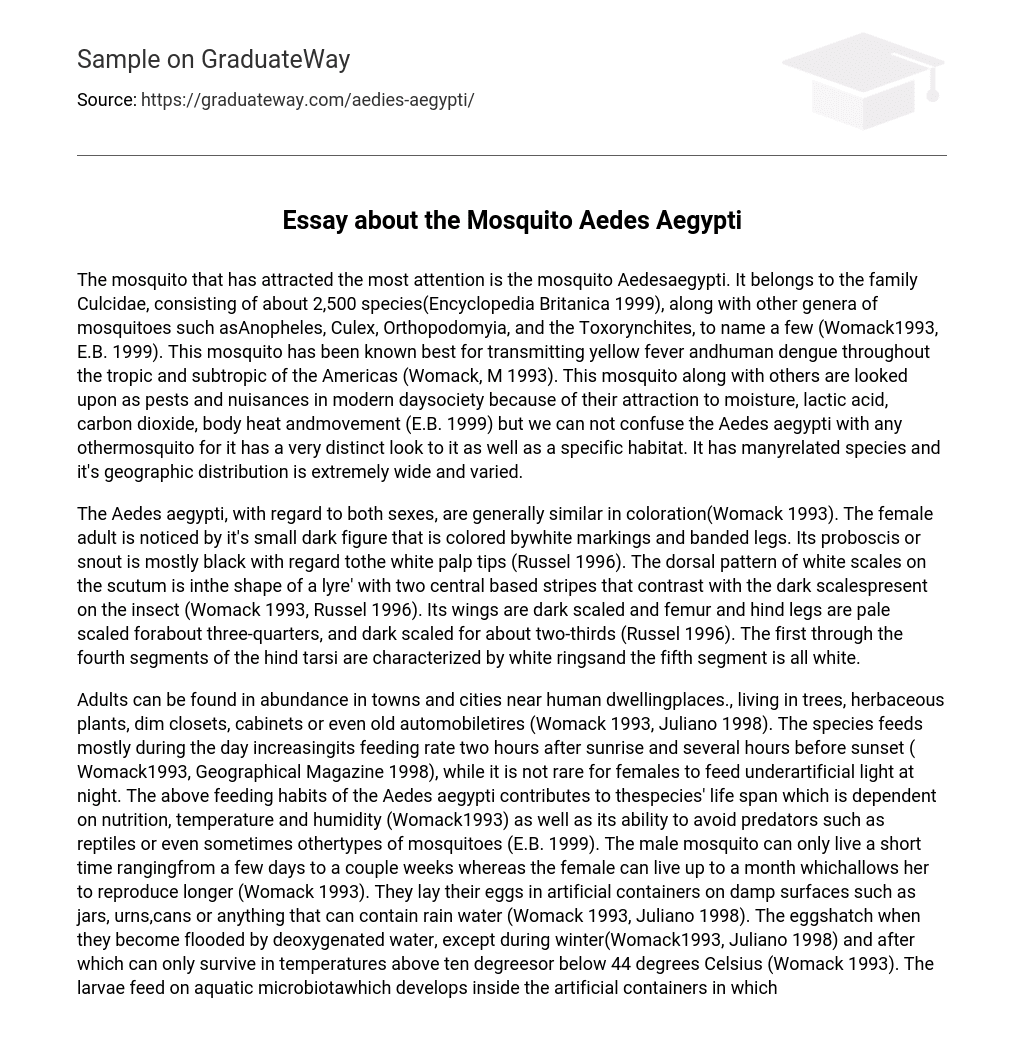The mosquito that has attracted the most attention is the mosquito Aedes aegypti. It belongs to the family Culicidae, consisting of about 2,500 species (Encyclopedia Britannica, 1999), along with other genera of mosquitoes such as Anopheles, Culex, Orthopodomyia, and the Toxorhynchites, to name a few (Womack, 1993; Encyclopedia Britannica, 1999). This mosquito has been best known for transmitting yellow fever and dengue fever to humans throughout the tropics and subtropics of the Americas (Womack, 1993). This mosquito, along with others, is considered a pest and a nuisance in modern-day society because of its attraction to moisture, lactic acid, carbon dioxide, body heat, and movement (Encyclopedia Britannica, 1999). However, we cannot confuse Aedes aegypti with any other mosquito, for it has a very distinct appearance as well as a specific habitat. It has many related species, and its geographic distribution is extremely wide and varied.
Aedes aegypti, with regard to both sexes, is generally similar in coloration (Womack, 1993). The female adult is noticed by its small dark figure that is colored by white markings and banded legs. Its proboscis or snout is mostly black with regard to the white palp tips (Russel, 1996). The dorsal pattern of white scales on the scutum is in the shape of a lyre with two centrally based stripes that contrast with the dark scales present on the insect (Womack, 1993; Russel, 1996). Its wings are dark-scaled, and its femur and hind legs are pale-scaled for about three-quarters and dark-scaled for about two-thirds (Russel, 1996). The first through the fourth segments of the hind tarsi are characterized by white rings, and the fifth segment is all white.
Adults can be found in abundance in towns and cities near human dwelling places, living in trees, herbaceous plants, dim closets, cabinets, or even old automobile tires (Womack, 1993; Juliano, 1998). The species feeds mostly during the day, increasing its feeding rate two hours after sunrise and several hours before sunset (Womack, 1993; Geographical Magazine, 1998), while it is not rare for females to feed under artificial light at night. The above feeding habits of Aedes aegypti contribute to the species’ lifespan, which is dependent on nutrition, temperature, and humidity (Womack, 1993), as well as its ability to avoid predators such as reptiles or even sometimes other types of mosquitoes (Encyclopedia Britannica, 1999).
The male mosquito can only live a short time ranging from a few days to a couple of weeks, whereas the female can live up to a month, which allows her to reproduce longer (Womack, 1993). They lay their eggs in artificial containers on damp surfaces such as jars, urns, cans, or anything that can contain rainwater (Womack, 1993; Juliano, 1998). The eggs hatch when they become flooded by deoxygenated water, except during winter (Womack, 1993; Juliano, 1998), and after which can only survive in temperatures above ten degrees or below 44 degrees Celsius (Womack, 1993). The larvae feed on aquatic microbiota, which develops inside the artificial containers in which the eggs are laid (Womack, 1993). “In the pupal stage, they are free-swimming and active, and breathe by means of tubes on the thorax (E.B. 1999). The limitations on the availability of habitat have greatly affected the geographic distribution of the species.”
“They have a cosmopolitan range extending from 40 degrees N to 40 degrees S latitude,” says Womack (1993). It is found throughout the world in tropic and subtropic regions (Womack 1993). The species has been distributed throughout New England, staying close to the marshes and damp areas and away from dry and cold climates. It is not only the dry and cold climates that threaten Aedes aegypti but one of its associated species as well. Aedes albopictus is an Asian mosquito that was introduced to North America in the 1980s (Hawley 1988, OMeara et al. 1992, 1993, 1995, Juliano 1998). It has spread throughout the north and now threatens declines in Aedes aegypti because of its “positive population growth at higher combined density and lower per capita resource availability” (Juliano 1998).
A. albopictus is a successful invader because of its generalized habitat, its adaptation to many climates, ability to live in human-dominated areas, as well as its food requirements and desiccation-resistant eggs (Hawley 1988, Focks et al. 1994, Juliano 1998). “The primary determinant of success,” says Juliano (1998), “was survivorship to adulthood.” Aedes aegypti only survived well in its environment when it was raised alone at a low density with high resource availability (Juliano 1998).
Competition for these resources among larvae seems sufficient in accounting for the near replacement of A. aegypti with A. albopictus. It is a species that lives to survive, feed, and reproduce, and although this may not seem difficult, Juliano has shown us that Darwin’s theory of evolution and natural selection is one that prevails in all species of organisms, and in this battle, A. aegypti is losing to a fellow, more adapted mosquito, A. albopictus. Some other related species of A. aegypti are A. notoscriptus (Russel 1996), A. triseriatus, A. atropalupus, Othopodomyia signifera, Toxorhynchites rutilis, Culex nigripalpus, Culex quinquefasciatus, Culex restuans, and Culex salinarius (Womack 1993).
A. aegypti is a species best known for infecting people with such diseases as yellow fever and human dengue. Its life cycle is very simple compared to that of many other organisms. The female feeds on a blood diet to mature her eggs (E.B. 1999), and she lays them in a damp artificial container. The time for development of these eggs to mosquitoes is anywhere from four to ten days depending on the water temperature and food supply (Womack 1993). Soon after the organism passes through the pupal stage, they mate and start the cycle over again.





